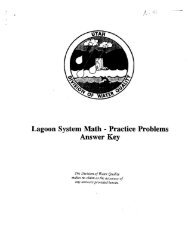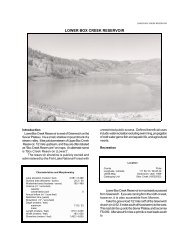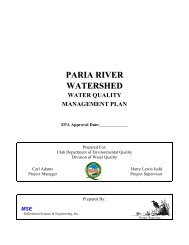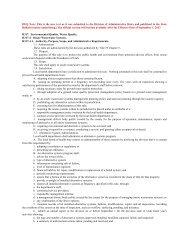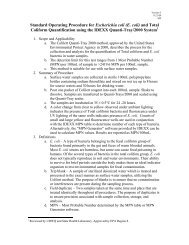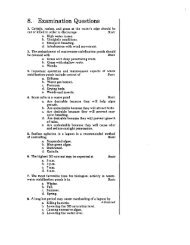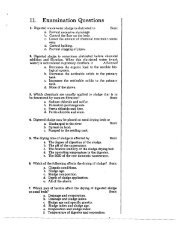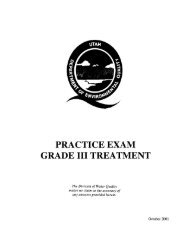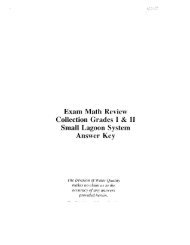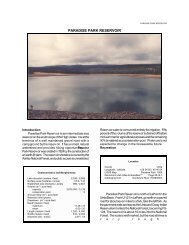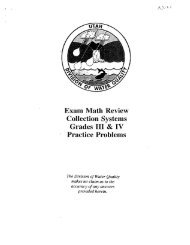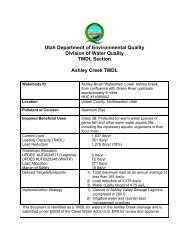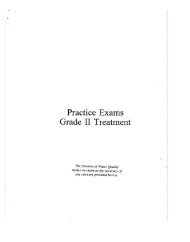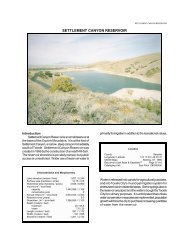An ASR PrimerCortney C. Br<strong>and</strong> – R.W. Beck Inc.streambedvadosezone wellrecharge basinsvadose zonerecharge/recoverywellThat Which We Call ASR...…others may not. In preparing this issue,<strong>Southwest</strong> <strong>Hydrology</strong> polled numerousexperts for the best term to describethe process of recharging aquifers (by avariety of means using a variety of sourcewaters), storing water (for short to longperiods), <strong>and</strong> then recovering water (fromthe same or other wells). We receivedmany opinions <strong>and</strong> no clear consensus.The top c<strong>and</strong>idates, none of which include“recharge,” “storage,” <strong>and</strong> “recovery,” are:<strong>Aquifer</strong> <strong>Storage</strong> <strong>and</strong> <strong>Recovery</strong> (ASR):To some, this means strictly recharge<strong>and</strong> recovery from the same well. Othersbelieve it is the most widely recognizedterm—at least in the <strong>Southwest</strong>—to referbroadly to all forms of aquifer recharge,storage, <strong>and</strong> recovery.Managed <strong>Aquifer</strong> <strong>Recharge</strong> (MAR):Has the greatest international use; lesscommon in this country. The originaldefinition referred to intentional banking<strong>and</strong> treatment of water in aquifers.Managed Underground <strong>Storage</strong> ofRecoverable Water (MUS): Introduced in2008 by NRC’s Committee on SustainableUnderground <strong>Storage</strong> of RecoverableWater to define “purposeful recharge ofwater into an aquifer system for intendedrecovery <strong>and</strong> use as an element of longtermwater resource management.”<strong>Southwest</strong> <strong>Hydrology</strong> is using the broaddefinition of ASR.Most water resourcesprofessionals have heardof ASR, or aquifer storage<strong>and</strong> recovery, but it can mean differentthings to different people. ASR can meanartificial recharge, groundwater recharge,managed aquifer recharge, undergroundwater storage, conjunctive use, or acombination thereof. For purposes ofthis <strong>and</strong> accompanying articles, ASRis a water management technique thatencompasses the purposeful recharge<strong>and</strong> temporary storage of water in anaquifer with the intent to recover all ora portion of the water from the sameaquifer in the future. Without the intentto, or act of, recovering recharged waterit is simply groundwater recharge.ASR is thought to have originated severalhundred years ago in the Kara Kum Plainof Turkmenistan <strong>and</strong> in Western India(Pyne, 1995), but is now conducted insome form on every continent exceptAntarctica. The motivators <strong>and</strong> potentialbenefits of ASR vary based on geography,hydrology, water chemistry, <strong>and</strong> waterpolicies/laws. A majority of the <strong>Southwest</strong>is arid or semi-arid, susceptible todrought, <strong>and</strong> characterized by declininggroundwater levels, unreliable surfacewater supplies, <strong>and</strong> overappropriatedrivers. As a result, the capture <strong>and</strong> storageof water when it is available is criticalto sustainable water management. Thetraditional approach has been to store wateraboveground by constructing dams <strong>and</strong>reservoirs. The benefits of abovegroundstorage include rapid fill <strong>and</strong> release,large storage capacities, straightforwardmeasurement <strong>and</strong> management, <strong>and</strong>opportunities for recreation. However,escalating costs <strong>and</strong> environmentalpermitting requirements associated withsurface reservoirs, as well as decliningavailability of l<strong>and</strong> <strong>and</strong> suitable sites, havedriven water professionals to explore ASRas an alternative.Implementing ASRWhere feasible, storing water undergroundcan save money, increase yields, mitigatethe impacts of drought, firm up surfacewater supplies, improve water quality,<strong>and</strong> avoid evaporative losses. Thenecessary ingredients are 1) an aquiferof suitable character, 2) source water ofsuitable quality, 3) the means to transmitthe source water into the aquifer, <strong>and</strong>4) the means to recover it. ASR can beaccomplished in bedrock, alluvial, orlimestone aquifers as long as the formation16 • May/June 2008 • <strong>Southwest</strong> <strong>Hydrology</strong>
can receive, store, <strong>and</strong> transmit waterwithout adversely impacting nativegroundwater or source water quality.There are myriad configurations <strong>and</strong>methods of implementing ASR, <strong>and</strong> theinherent variability of natural systemsnecessitates site-specific solutions.Suitable source waters can include surfacewater diverted from streams, stormwaterrunoff, remediated groundwater,reclaimed water, <strong>and</strong> industrial-processwater. Water can be transmitted intoan aquifer using nonstructural meanssuch as natural drainages or structuralmeans such as impoundments, basins,trenches, injection wells, vadose zonewells, or combinations thereof. SomeASR systems, because of the nature ofthe water source, require abovegroundstorage to capture <strong>and</strong> hold water beforeit can be transmitted underground. Waterrecovery is typically accomplished throughwells; however, some ASR systems utilizenatural discharge of groundwater to astream as a virtual means of recovery.ASR is practiced by governmentalentities <strong>and</strong> water utilities throughoutthe <strong>Southwest</strong>. Some familiar examplesinclude Scottsdale, Tucson, Orange County,Las Vegas, El Paso, Salt River Project,Central Arizona Project, <strong>and</strong> MetropolitanWater District of Southern California(MWD). Most of these entities utilize thevast storage capacity available in alluvialfillbasins. In contrast, entities situatedalong Colorado’s Front Range, includingHighl<strong>and</strong>s Ranch <strong>and</strong> Colorado Springs,utilize deep bedrock aquifers of the DenverBasin. The City of San Antonio utilizes theEdwards <strong>Aquifer</strong>, a cavernous limestoneformation. Other examples of ASR includewater conservation districts in the San LuisValley <strong>and</strong> the lower South Platte Riverin Colorado, the Wintergarden region ofsouth Texas, <strong>and</strong> the Jordan Valley WaterConservancy District in central Utah.As illustrated in the table below, theseprojects vary in their objectives, watersources, aquifer characteristics, <strong>and</strong> meansof recharging <strong>and</strong> recovering water.Challenges to OvercomeAlthough the potential benefits of ASRare numerous, ASR also poses significantchallenges. These primarily revolvearound issues of water quality; waterrecovery; the management, monitoring,<strong>and</strong> accounting of recharged water; waterrights; <strong>and</strong> source water availability.These challenges are geographicallydependent due to interstate <strong>and</strong> intrastatevariations in water administration, localhydrology, <strong>and</strong> aquifer characteristics.ASR is typically accomplished usingwater derived from a source other than thereceiving aquifer. Waters from differentsources can have different chemistries,pH, temperatures, <strong>and</strong> redox conditions.Mixing dissimilar waters underground<strong>and</strong> exposing aquifer materials to nonnativewater can drive geochemicalreactions that alter water chemistry. Somepotential impacts include dissolution ofarsenic compounds <strong>and</strong> precipitation ofclays. Water quality changes can alsooccur as water percolates through thevadose zone <strong>and</strong> encounters evaporitedeposits or leaching zones underlyingagricultural areas. <strong>Recharge</strong>d water canacquire salts <strong>and</strong> nitrogen compounds asit percolates to groundwater, degradingsource water <strong>and</strong> groundwater quality.The increased use of reclaimed waterfor ASR has created an emerging waterquality issue posed by pharmaceuticals <strong>and</strong>endocrine disrupting compounds. Thesecontaminants occur in wastewater at verylow concentrations <strong>and</strong> are not effectivelysee ASR Primer, page 32Entity / Project Objective Water Source <strong>Aquifer</strong> Type <strong>Recharge</strong> Method <strong>Recovery</strong> MethodArizonaCity of Scottsdalestore excess surface water <strong>and</strong> stormwater treated CAP water, reclaimed water alluvial basin direct injection wells, production <strong>and</strong> dual-use wellsrunoffvadose zone wellsSalt River Project store excess surface water CAP water, surface water (Salt <strong>and</strong> Salt River basinsto be determinedVerde rivers), reclaimed water alluviumCentral Arizona Project (CAP) store excess surface water CAP water alluvial basin basins to be determinedTucson Watertreat <strong>and</strong> store surface water <strong>and</strong> reclaimed CAP water, reclaimed water alluvial basin basins production wellswaterVidler <strong>Recharge</strong> Facility store surface water CAP water alluvial basin basins, vadose zone wells to be determinedCaliforniaOrange County Water District long-term storage, groundwater surface water (from MWD), alluvial basin direct injection wells, inlieu,production wellsreplenishmentstormwater runoff, reclaimed waterbasinsCoachella Valleylong-term storage, groundwater surface water (from MWD), All- alluvial basin in-lieu, basins production wells, water transferreplenishmentAmerican CanalTexasCity of El Paso recharge aquifer <strong>and</strong> store water reclaimed water alluvial basin direct injection wells, basins production wellsCity of San Antoniostore seasonally available Edwards <strong>Aquifer</strong> groundwater alluvial basin direct injection wells production wellswaterWintergarden Groundwater enhance recharge to the Carrizo aquifer stormwater runoff s<strong>and</strong>stone impoundments, passive production wellsConservation DistrictwellsColoradoCentennial Water & Sanitation store excess surface water surface water (S. Platte River) s<strong>and</strong>stone direct injection wells production <strong>and</strong> dual-use wellsDistrictColorado Springs Utilities store excess surface water surface water (Colorado River) s<strong>and</strong>stone direct injection wells dual-use wellsLower South Platte Water streamflow augmentation, wildlife recovery surface water (S. Platte River) <strong>and</strong> S. Platte River basins <strong>and</strong> ditches accretion to riverConservancy Districtalluvial wellsalluviumNevadaLas Vegas Valley Water District store excess surface water surface water (Colorado River) alluvial basin direct injection wells production <strong>and</strong> dual-use wellsExamples of ASR projects in the <strong>Southwest</strong>. Note: CAP water is untreated Colorado River.May/June 2008 • <strong>Southwest</strong> <strong>Hydrology</strong> • 17



